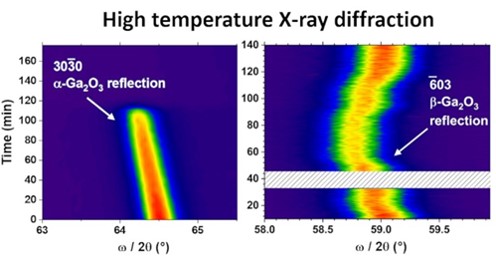How stable are gallium oxide layers at high temperatures? Scientists from the Institute of Electrical Engineering of the Slovak Academy of Sciences set out to answer this question. Their research provides crucial insights into a promising semiconductor material – gallium oxide (Ga₂O₃) – which has attracted significant interest from both scientific and industrial communities due to its exceptional properties.
Gallium oxide stands out because it offers advantages over traditional semiconductors used in high-power and high-voltage applications. It can also be produced as bulk crystals, which are essential for creating thin Ga₂O₃ films used in microelectronic devices. This makes it a potentially cost-effective technology with the potential to enhance the capabilities of current high-power systems, paving the way for innovations like fast chargers for electric vehicles and more efficient voltage converters.
In this study, the team successfully prepared thin films of two different phases of Ga₂O₃ – the metastable α-phase and the stable β-phase – on sapphire substrates. These films were produced using a specialized technique known as metalorganic chemical vapor deposition with liquid precursor delivery (LI-MOCVD). To test their thermal stability, the films were gradually heated up to 1100 °C in a vacuum chamber while their structural properties were closely monitored.
The results revealed that the β-phase remained stable even after 30 minutes at the highest temperature. In contrast, the α-phase showed different levels of thermal resistance, withstanding 20 minutes at 700 °C, 10 minutes at 750 °C, and 8 minutes at 800 °C before finally degrading at 850 °C. The team also observed signs of increasing mechanical strain during heating, which disappeared once the films were cooled back to room temperature.
“These results represent an important insight that allows us to develop a technology for the production of Ga2O3 components that ensures that the material itself is not degraded during manufacture,” concludes Filip Gucmann.
This research advances our understanding of the thermal stability of gallium oxide layers, paving the way for more reliable and efficient semiconductor devices. By identifying the temperature limits of different Ga₂O₃ phases, this study provides valuable information for the development of high-power and high-voltage applications, including electric vehicle chargers and voltage converters.

Figure: Records of X-ray diffraction measurements corresponding to signal intensities from α- (left) and β-Ga2O3 (right) layers heated up to 1100°C.
Authors: Filip Gucmann, Peter Nádaždy, Kristína Hušeková, Edmund Dobročka, Juraj Priesol,
Fridrich Egyenes, Alexander Šatka, Alica Rosová, Milan Ťapajna
Link: https://www.sciencedirect.com/science/article/pii/S1369800122008162





